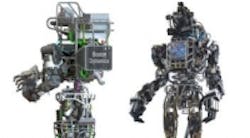Teams to compete to program Terminator-style robot
In the not-so-distant future,Terminator-like robots may be assisting with disaster-response efforts like cleaning up and searching for survivors after natural disasters, in addition to other human tasks. ATLAS is a humanoid robot with functioning limbs and hands that was built by Boston Dynamics for the Defense Advanced Research Projects Agency (DARPA). The robot features a head-mounted MultiSense-SL3D data sensor package with LIDAR, and stereo cameras so users controlling Atlas can see what the robot sees. It also features an on-board real time control computer, and near human anthropometry with 28 hydraulically-actuated joints. DARPA is holding a competition, the DARPA Robotics Challenge, in which teams in the B/C track compete to earn the chance to further develop the robot, according to Extreme Tech. (Teams in the A track are developing their own robots.) The teams that finish in the top six each receive an ATLAS robot and funding from DARPA for the second round, which takes place in December 2013. DARPA was able to allocate additional funding for three teams, however, after the Jet Propulsion Laboratory team decided to merge its Atlas effort with its existing DARPA Track A effort and offer the bulk of the resources to the other teams.
The current Atlas is a “shell” and these teams will compete to provide the robot with a brain. Each team will each load up their Atlas robot with its software and compete in a series of disaster response trials in December 2013. Following round two, top finishers will receive continued DARPA funding and will compete in the DARPA Robotics Challenge Finals. The winner of the finals receives $2 million from DARPA and more than likely, a contract for the commercial production of Atlas. Thegoal of the Atlas robot was to spur the development of a robot that can remove humans from dangerous areas to allow issues to be mitigated from a safe location.
View more about theAtlas program.
Also check out:
Robot snakes inspect nuclear power plant
Vision-enabled humanoid robot builds 3D visual maps
Vision-guided robots will restore coral reefs
Share your vision-related news by contactingJames Carroll, Senior Web Editor, Vision Systems Design
To receive news like this in your inbox,click here.
About the Author

James Carroll
Former VSD Editor James Carroll joined the team 2013. Carroll covered machine vision and imaging from numerous angles, including application stories, industry news, market updates, and new products. In addition to writing and editing articles, Carroll managed the Innovators Awards program and webcasts.
